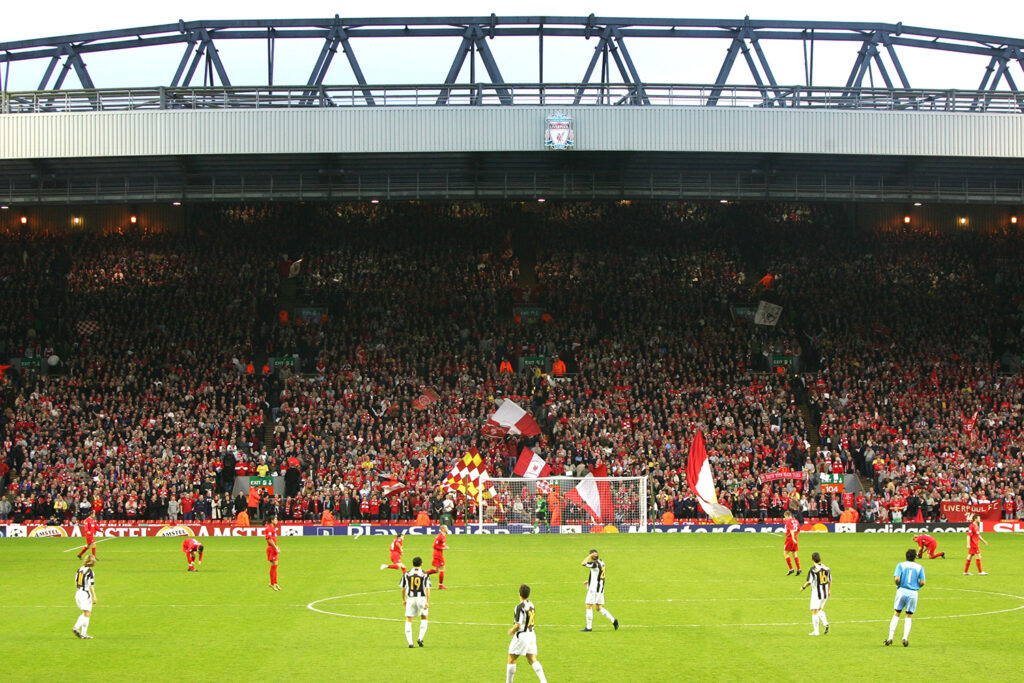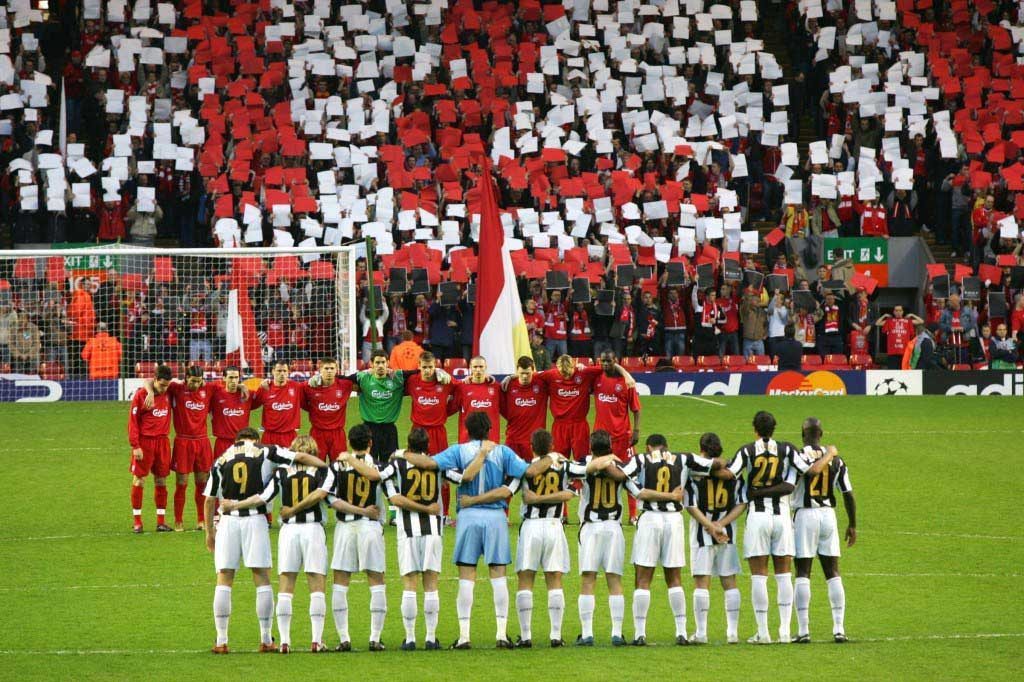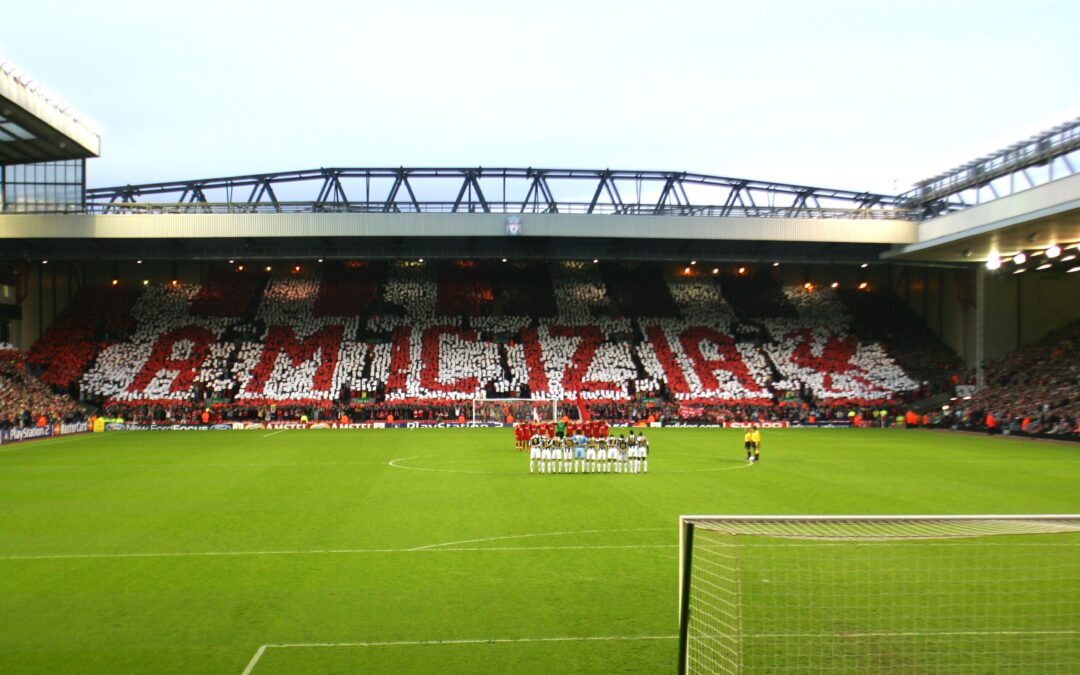
LIVERPOOL, ENGLAND – TUESDAY APRIL 5th 2005: Liverpool and Juventus during the UEFA Champions League Quarter Final 1st Leg match at Anfield. (Pic by David Rawcliffe/Propaganda)
WITH the lies, the smears and cruel myths about the Hillsborough disaster exposed once and for all by the publication of the Hillsborough Independent Panel’s report, those who clung to them out of warped tribalism have but one straw left to clutch. “What about justice for Heysel?”, they plead. “What about the truth of what happened there?”
Actually, they might have a point, writes OLIVER KAY, even if they raise it out of malice rather than consideration for the bereaved. The publication — and belated national acceptance — of the real truth about Hillsborough has been a source of great vindication for all who were affected by that tragedy. But questions undoubtedly remain about the Heysel Stadium disaster, in which 39 spectators — 32 from Italy, four from Belgium, two from France, one from Northern Ireland — were killed in a stampede before the 1985 European Cup final between Liverpool and Juventus.
Those bereaved and outraged by Hillsborough have fought to keep their campaign for justice alive and been entirely vindicated for doing so. By contrast, Heysel remains the tragedy that dares not speak its name. So let us talk about it. Let us state a few of the facts about whether justice was done.
We all know that English football, collectively, was punished, with clubs excluded from Uefa competition. Liverpool immediately withdrew, in disgrace, from the next season’s Uefa Cup. Within hours the FA, under pressure from the government, announced that no English club would play in the following season’s Uefa competition — and that of course included Everton, denied a tilt at the European Cup, and Norwich City, denied a first ever European campaign. Two days later Uefa announced an indefinite ban on English clubs. It ended up at five years, with Liverpool serving a sixth as punishment for their supporters’ behaviour at Heysel.
This was not a knee-jerk reaction to a one-off night of mayhem. This — both the sanction and, it could be argued, the widespread loss of life — had been coming. Heysel was the disgraceful culmination of more than a decade of ugly incidents involving English supporters on their European travels: Tottenham Hotspur in Rotterdam in 1974 and 1983, Leeds United in Paris in 1975, Manchester United in St Etienne in 1977, the national team in Basle in 1981 and so on until the spiral of moronic violence reached its tragic conclusion — logical in one sense, crazy in all others — in Brussels.
As to whether individuals were brought to account, 27 arrests were made on suspicion of manslaughter and 26 men were charged. (These, incidentally, do not tend to be described as Liverpool supporters — in part because of claims at the time from John Smith, the club’s chairman, and two Merseyside councilors, that National Front members from London had been responsible. There are many sensitive issues here, but let us not pussyfoot over this one. As Tony Evans, football editor of The Times and author of Far Foreign Land, a brilliant book about his experiences following Liverpool at Heysel and all over Europe, put it: “It was a red herring. Hooligans from the far right would not have been welcome.”)
The prosecutions stemmed from television camera footage of the charge — the third such charge in a matter of minutes — that led directly to the deaths of those 39 innocent spectators. There are dozens of points that are usually offered to explain the context, not least over ticketing, segregation and a crumbling stadium, but the context does not begin to excuse what happened. No amount of context ever could.
Those stampedes might have been considered standard terrace fare at the time, a token act of territorialism and intimidation, but it led innocent fans to flee in terror. Some tried to climb a wall to escape. The wall crumbled. Thirty-nine people were crushed to death. The world was appalled. Turin went into mourning. Liverpool and their supporters were left to live with what they now know to be an indelible stain.
As for “justice”, an initial inquiry by Marina Coppieters, a leading Belgian judge, found after 18 months that the police and the authorities, in addition to Liverpool supporters, should face charges. Quite apart from the hooliganism, ticketing arrangements and police strategy and responses were criticised. By this stage, English supporters were regarded across Europe as such animals that shock was expressed at how the authorities had played into their hands.
There was bewilderment, too, at the choice of stadium. And where have you heard that before? Uefa chose a ground that had been built in the 1920s and condemned in the early 1980s for failing to meet modern safety standards, which were far from stringent. Evans recalls that the outer wall, made of cinder block, was decaying, that he was not required to show his ticket and that, long before the stampede, he saw a crash barrier in front of him crumble.
Jacques Georges, the Uefa president at the time, and Hans Bangerter, his general secretary, were threatened with imprisonment but eventually given conditional discharges. Albert Roosens, the former secretary-general of the Belgian Football Union (BFU), was given a six-month suspended prison sentence for “regrettable negligence” with regard to ticketing arrangements. So was gendarme captain Johan Mahieu, who was in charge of the policing the stands at Heysel. “He made fundamental errors,” Pierre Verlynde, the judge, said. “He was far too passive. I find his negligence extraordinary.”
https://www.youtube.com/watch?v=JZmji-IzEgA
In 1989, after a five-month trial in Brussels, 14 of the 26 Liverpool supporters who stood trial were found guilty of involuntary manslaughter and given a three-year prison sentence, suspended for 18 months, and each ended up serving about a year in total in behind bars. The remaining 10 defendants were acquitted of manslaughter, but some had their £2,000 bail money confiscated, having been absent for part of the trial. And civil damages estimated at more than £5million were provisionally awarded to families of the Heysel victims against the convicted fans and the BFU.
But you never hear of this because the tragedy is taboo. It was only brought into the open when Liverpool and Juventus were drawn together in the Champions League quarter-final in 2005, at which point the Merseyside club, after consultation with their Italian counterparts, announced it would be a game of “friendship”.

Before the first leg at Anfield, Liverpool supporters held up a mosaic to form the word “amicizia”. Some of the visiting Juventus fans applauded. Most, it seemed, turned their backs in disgust. And while the rejection of the olive branch met with a little consternation on Merseyside, Liverpool’s supporters know all too well about the type of apology that comes too late, brought by events, to sound truly sincere.
Heysel is an unspeakably awkward subject for Liverpool — perhaps more, perhaps less, for the anguish the club and the city endured four years later at Hillsborough. It is a black mark and it will be there forever. Supporters of rival teams chant “Murderers” and the Liverpool fans have little response. On one infamous occasion at Goodison Park in 2008, the away fans responded by singing “2-0 to the Murderers”. I know that this was somewhere between a knee-jerk response and an attempt to “reclaim” that offensive description, but it sounded awful. Were they listening in Turin? You would hope not.
For many years, Liverpool ’s response to Heysel was woefully inadequate. I was shown a copy of the club’s official yearbook for 1985-86. There were two articles about the tragedy on page three, but they were both of the “Let’s put this behind us, improve the matchday Anfield atmosphere and look to restore the club’s good name” variety. There was no direct reference to what had happened. There was no hint of an apology. Later there was a round-up of the previous European Cup campaign, in which 1985-86 was identified as a “watershed” because it would be Liverpool ’s last for some time.
Over time, there was a recognition that more — much more — needed to be done. In 2000 the city of Liverpool officially commemorated the anniversary of Heysel for the first time – on the suggestion, incidentally, of Peter Millea, the chairman of Liverpool City Council’s Hillsborough disaster working party.
They do at least now have a memorial plaque at Anfield, they do have extensive coverage of the tragedy on their official website and they do pay tribute on May 30 every year, even if it took far too long for the club to recognise the tragedy and the stain it had left — not unlike Sheffield Wednesday with Hillsborough, although the circumstances there involved appalling failures at executive level.
Heysel is a huge stain on Liverpool ’s history. It is undeniable. And yet none of this diminishes the club’s or the supporters’ right to grieve or to campaign or to express anger over what happened in Sheffield four years later.
One real mystery surrounding Heysel is that the tragedy is even more of a taboo in Turin.
For many years the bereaved met with what they perceived to be a sense of denial from Juventus about a disaster that overshadowed the club’s long-awaited first European Cup win. In The Truths of Heysel — a book written by Andrea Lorentini, whose father Roberto died in Brussels and whose grandfather Otello led the campaign for the victims to be officially recognised by the club — writes of the “bewilderment, reticence, guilty silences and suspicion” the bereaved faced in their dealings with Juventus.
Justice for Heysel? There can never be justice for 39 lives lost at a football match, but it is in Turin, not on Merseyside, that the cries of the bereaved have met with silence down the years.
The families do not want their lost ones to become a cause celebre in England, particularly not when the purpose has purely been to score points on the terraces. A little more recognition closer to home is what they want.
Oliver Kay is Chief Football Correspondent for The Times
LISTEN: Podcast – Heysel 30 Years
READ: Heysel 30 Years: The Barbarians are Coming
READ: Heysel 30 Years: When In Rome
READ: Heysel 30 Years: Why Did No-One See It Coming?
READ: Heysel 30 Years: An Eyewitness Account Of May 29, 1985 In Brussels
READ: Heysel 30 Years: Oh God, What Have We Done?
READ: Heysel 30 Years: The Italian View
READ: Heysel 30 Years: What About Justice For The 39?












Good on TAW for addressing the subject and this is the best article on it so far. Doesn’t beat about the bush or try to contextualise. Some things just need to be fronted up to no matter how awkward or uncomfortable they may be. Good piece.
“There can never be justice for 39 lives lost at a football match, but it is in Turin, not on Merseyside, that the cries of the bereaved have met with silence down the years.”
You just can’t help yourself, can you? Try and write an article about Heysel and Liverpool FC’s failures over it, but you can’t help saying “Really, Juventus are the real baddies, point the finger at them”. There’s always someone else to blame.